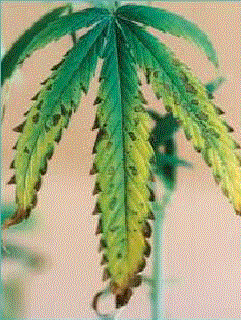Summary
Potassium is present throughout plants and is required for all water-related transport activities in plants including opening and closing the stomas. Potassium is also responsible for the plants’ strength and quality and it controls countless other processes such as carbohydrate management.
The Romans and Etruscans improved the soil with potassium by burning down the local vegetation and this form of slash-and-burn has been employed throughout the world during the last centuries and has resulted in enormous soil erosion. In the thirties, wood ash mixed with stable manure was frequently used in the Netherlands.
Potassium is a soft, silver-white metal that reacts very violently with water and light in its pure form. 300 million years ago minerals such as potassium, sodium and magnesium became dissolved in the sea due to soil erosion. The seawater evaporated in large sea basins and the salts crystallised. This created the salt formations in Alsace in south-western Germany. Around the turn of the century only table salt was extracted from these formations and the excess potassium salt was discharged into the Rhine. Because of the increasing use of inorganic fertilizers, other minerals such as magnesium, sulphur (Epsom salts), phosphorus and boron are now extracted from these mines as well as table salt and potassium.
- In the beginning you see a healthy looking, dark green plant with semi-shiny leaves that later become dull.
- Plants often have more side shoots than is normal and stems remain thinner.
- The points of the young leaves get grey edges, later turning rust brown, necrotic and they shrivel and curl up.
- The leaves turn yellow progressing from the edge towards the veins and necrotic, rust brown spots appear in the leaf.
- The leaves often turn or curl radially in the top, entire leaves become necrotic and they continue to curl and then fall off (old leaves).
- If it is a severe deficiency the plant will look dull and unhealthy and flowering will be severely inhibited
Developments in chronological order:
Symptoms
A potassium deficiency inhibits evaporation which causes the temperature in the leaves to rise and this burns the cells. This mainly happens on the edges of the leaves where most evaporation normally occurs.
Note: Dead leaf edges can also be caused by other conditions such as the atmospheric humidity being too high and too much salt!
This makes it impossible to diagnose a potassium deficiency purely on the basis of external symptoms. Generally speaking, symptoms can be diagnosed as being due to a deficiency when approximately 10% of an element is missing from the plant tissues. The symptoms can be seen above the ground in the form of colour changes and the plant dying back.
Developement:
- In the beginning you see a healthy looking, dark green plant with semi-shiny leaves that later become dull.
- Plants often have more side shoots than is normal and stems remain thinner.
- The points of the young leaves get grey edges, later turning rust brown, necrotic and they shrivel and curl up.
- The leaves turn yellow progressing from the edge towards the veins and necrotic, rust brown spots appear in the leaf.
- The leaves often turn or curl radially in the top, entire leaves become necrotic and they continue to curl and then fall off (old leaves).
- If it is a severe deficiency the plant will look dull and unhealthy and flowering will be severely inhibited!
Possible causes of potassium deficiency
The causes for a cannabis plant to lack potassium can be grouped in three category:
- Insufficient or incorrect fertilisation
- The cultivation is on soil that fixes calcium.
- Excessive ‘table salt’(sodium) in the root environment.
What should you do?
- Go to the shop for expert advice. They specialise in this crop and have the right products available. Properly prepared fertilizer contains enough potassium.
- Rinse the growing medium well with clean water if the EC in is too high.
- You can add potassium yourself, the easiest method being inorganically by dissolving 5 – 10 gr of potassium nitrate in 10 litres of water. With acidic growing mediums you can add extra potassium bicarbonate or caustic potash (5 ml in 10 litres water).
- You can also add potassium organically by adding a watery solution of wood ash, chicken manure or semi-liquid manure but be careful to avoid burning. Grape and vine extracts also contain a lot of potassium.
Warning: Adding potassium too enthusiastically can lead to salt damage, calcium and magnesium deficiencies and acidification of the root environment!
